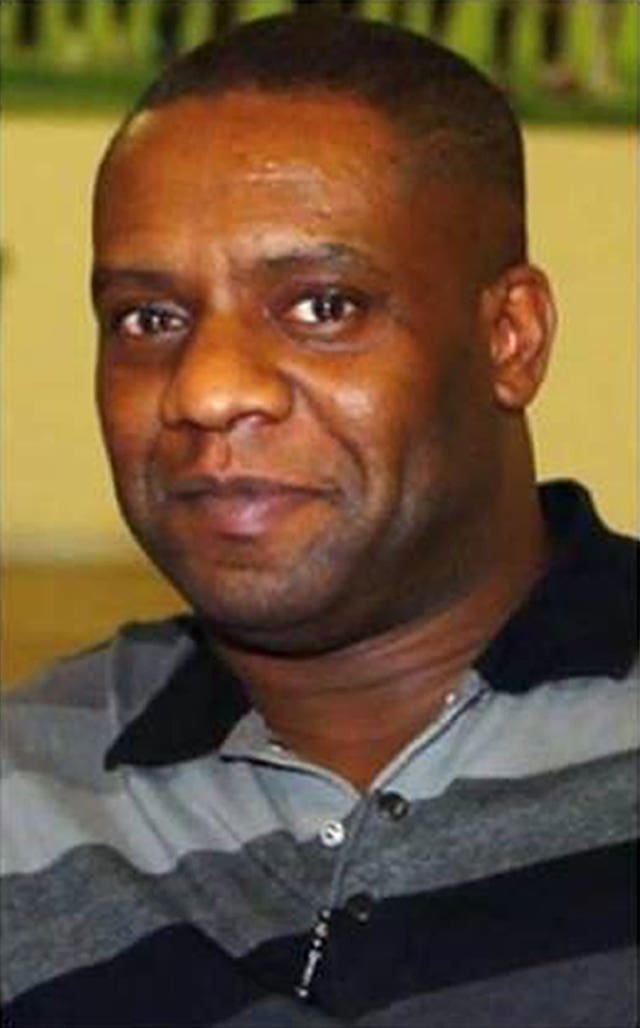Police officer ‘kicked Dalian Atkinson as a last resort’
Pc Benjamin Monk denies both murder and manslaughter over the death of the ex-Aston Villa star.

Counsel for a Pc accused of murdering Dalian Atkinson has claimed the ex-footballer was not motionless on the ground when he was kicked twice in the head “as a last resort” after the officer ran out of options.
Defence QC Patrick Gibbs also submitted that the length of a 33-second Taser deployment by Pc Benjamin Monk was the clearest evidence that it was delivered by mistake “in complete confusion and panic”.
Prosecutors claim Monk used unlawful and unreasonable force out of anger, prior to the death of former Aston Villa, Sheffield Wednesday and Ipswich Town striker Atkinson in August 2016.

Addressing the 11-member jury panel at Birmingham Crown Court on Thursday, Mr Gibbs said the evidence suggested Monk was frightened rather than angry during a six-minute confrontation with the former Premier League star.
Mr Gibbs told the court: “There was something about the way in which he (Atkinson) presented in the street which made (a witness inside a house) take ballistic cover and to tell his wife to do the same thing.”
Claiming Monk and Bettley-Smith had “never really recovered” from their first impression of Atkinson, Mr Gibbs added: “Events go from 0-60 in about a minute flat because that’s all it took for his psychotic state to manifest itself and for the Taser to be fired and for Miss Bettley-Smith to press her emergency button.”
After a first Taser firing had no effect on Atkinson, Mr Gibbs said, the ex-footballer had smashed a glass door panel at his father’s house, leaving Monk with “every reason to fear the worst”.
Mr Gibbs told the jury: “He (Monk) wasn’t wrong to be worried about the occupant.
“From what we now know, this incident could have ended very differently if Mr Atkinson had got back into the house.”
During his submissions, Mr Gibbs said of Monk: “He knew he was facing an aggressive, irrational, apparently powerful person who seemed not to be responsive to reason.
“He knew there was no (Taser) cartridge four. What he did not know was that two (police) cars and four officers were only about a minute away.
“Was Mr Monk angry or was he scared at that point? He had certainly been frightened enough moments before to run away.”

Witness after witness had spoken of initial attempts to pacify Atkinson, Mr Gibbs said, adding that Monk had used “his last resort last” and only when he had run out of other options.
Mr Gibbs asked: “What is the evidence that he was angry rather than frightened?
“There are no words of anger directed at Mr Atkinson. Upon proper analysis you may find it difficult to escape the conclusion that the prosecution say he was angry because they have to.
“Because only by alleging anger can they avoid the otherwise common sense conclusion that he acted as he did in the heat of the moment – maybe brilliantly, maybe not so brilliantly – to protect himself, to protect his probationary (police officer) girlfriend and the occupant (of the house).”
Claiming the forensic evidence showed Atkinson was not lying motionless before being kicked, Mr Gibbs invited the juror to consider if the third half-minute discharge of a Taser was the result of a “convulsive grip” of the weapon.
Mr Gibbs added that the jury had now heard the context of the kicks, which left two bootlace imprints on Atkinson’s forehead.
The barrister told the jury: “While it is still horrible to imagine those kicks, you have a better understanding of how in panic, if that is what it was, they might have been delivered as a last resort in the heat of the moment.”
The trial continues.





